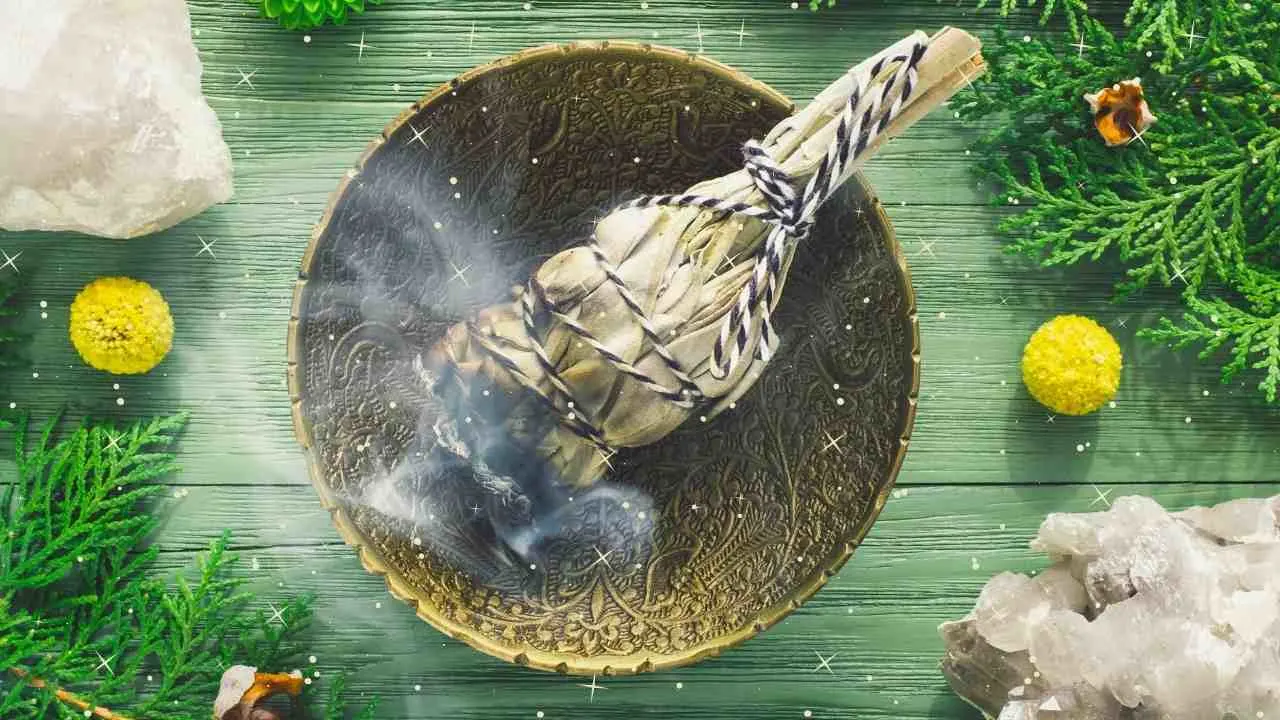‘Smudging’, the art of using burning bundles of dried herbs, usually sage, is very common – particularly in the US.
Every day see a new beginner try smudging.
Most modern versions of this practice come from the rituals of Indigenous Americans, but the burning of herbs and incense for cleansing dates back thousands of years and is found all over the world.
Smudging for beginners is a great way to start your spiritual journey. It’s simple, straightforward, and very powerful.
Sage itself is an herb with a long history of use in magic and ritual.
Some sources suggest that the burning of sage is a practice dating back over four millennia, and we have written records from Ancient Greece and Rome that use Salvia officinalis for medicinal purposes.
According to 16th Century writer John Gerard, it “is singularly good for the head and brain, it quickeneth the senses and memory, strengtheneth the sinews [and] restoreth health”.
In Britain, it is regarded as one of the four ‘essential’ herbs along with Parsley, Rosemary, and Thyme – as in the song ‘Scarborough Fair’.
What is Smudging?

Smudging itself is an old ritual practice of the Indigenous people of the North American continent used to cleanse homes and sacred spaces of negative energy.
It serves the dual purpose of both cleansing and ‘sanctifying’ – preparing a space for sacred purposes.
In the modern-day, smudging is also viewed as a way to raise positive energy by banishing the negative energies of a space.
Sage itself is a natural antimicrobial and has been used as a mild disinfectant on a physical as well as spiritual level throughout history.
Smudging does not have to be done with sage, although bundles of dried white sage are most common, particularly in North America.
You can also smudge with other herbs and resins, or even a combination of the two.
Cedar, sweetgrass, and rosemary are sometimes used in place of – or in combination with – sage.
Supplies Needed for Smudging
The only absolute essential you will need is the smudge stick itself – and something to light it with.
In the Indigenous American tradition, you would have a sacred bundle that also contained an eagle feather and an abalone shell.
However, with both eagles and abalone in sharp decline worldwide, many people prefer to substitute a bowl made of clay or copper for the shell and large feather or bundle of feathers from a more common bird – or one with a special meaning to them.
A fan will also work for this.
For safety reasons, it is important that your shell or bowl be able to contain your burning smudge, either for burning completely or to extinguish the embers.
Some choose to line the container with earth or sand to both put out the smudge and to ground any lingering energies at the end of the process.
The Smudging Process For Beginners
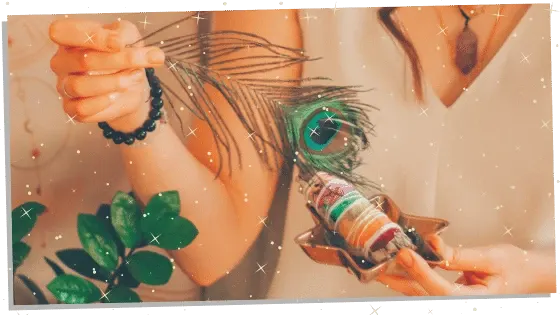
Step 1: Preparation
Begin by opening doors and windows in the space you are cleansing, including cupboards and storage spaces.
This is important on a physical and spiritual level as it both prevents a build-up of smoke and allows negative energies to escape or be forced out by the process.
Collect your materials and lay them out deliberately.
Where possible you should aim to avoid lighting your smudge from a lighter or matches, so having a small candle pre-lit, or lighting one is a good starting point as a ritual act.
Step 2: Intention
Not everybody sets an intention when smudging since the process itself is already intentional.
However, should you want to focus your mind on the task at hand, setting an intention or saying a small prayer can be a good way of elevating your mind to a higher state while staying present in the act of cleansing.
If you do choose to set an intention, this should always be phrased in a positive way – “Let this place be cleansed” is much better than “Get rid of negative energy”.
Step 3: Ignition
Hold your smudge stick over your fire-proof shell or bowl.
Using you candle (or other fire lighting source), set fire to the end of the stick furthest from your hand.
Let the fire kindle the whole end of the stick. Blow out the flame gently, leaving the embers glowing.
The stick will now start to release a cloud of smoke that will start to move on the air currents in your room.
Step 4: Dispersal
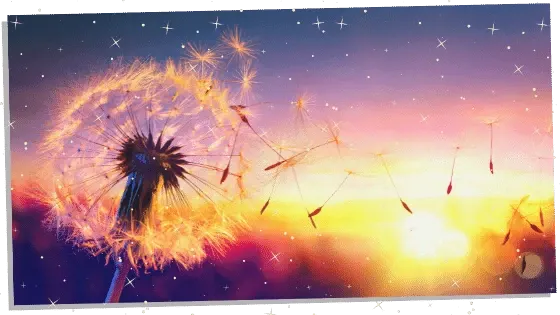
Start by wafting some of the smoke towards you with your feathers or fan to first anoint yourself.
Removing the negative energies from around yourself should always be a first step towards cleansing a space.
Move around the space you want to cleanse, if it is a single room or a whole building, take your time to wave the smoke into corners and dark places where negativity might linger.
Many prefer to move clockwise around a room for the positive intentions this creates but be guided by your intuition for what works best for you.
Try not to leave thick clouds of smoke to gather in place, you want it to spread out and move with you.
If need be, turn in place to generate some airflow.
If your smudge goes out, re-light it over your shell or bowl as in step 3.
Step 5: Release
There are different schools of thought on what to do once you have finished with your space.
Some people prefer to let their smudge burn all the way through, using it only once so as not to reduce its effectiveness.
Others will put it out using earth or sand and re-use the same stick more than once.
Partly, this can depend on the size of the space you are cleansing, the larger the space, the more you will likely use up your smudge stick.
A good compromise is to translate your remaining smudge to an outdoor space and let it keep burning.
This not only banishes negativity but creates a short-term barrier to its return, rendering your space cleaner for longer and serving as a small sacrifice of leftover smudge.
❤️ Related Post: The Fascinating History Of Smudging
FAQ for Beginners to Smudging
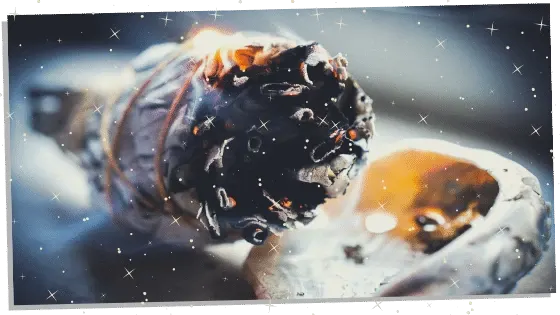
If you’re a beginner to smudging, you can fee a lot of pressure to ‘get it right’.
Many people feel concerned over the idea of cultural appropriation of another culture’s sacred rituals, but approaching the process with reverence and respect is the best way to start.
Here we answer some of the common questions asked by beginners.
Is it better to smudge at day or night?
There is no ‘set’ time to start smudging. Each practitioner from beginner to expert has their own best time.
Many smudge first thing in the morning or at dawn to clear out their space and begin the day with a pure space and a strong intention.
Others prefer to smudge at night before bed to close down their space and banish negativity before sleeping to encourage better dreams and more peaceful rest.
The best time to smudge is when you feel it is appropriate. You may choose to smudge at the same time every day, or only on special occasions.
How often should I smudge?
As a beginner to smudging, it needn’t be a part of your daily routine straightaway!
Some people do choose to start or end each day with a smudging session, but you will soon develop a feel for how often you feel it is appropriate.
Many beginners will only smudge once in a while or for specific ritual purposes or preparation.
Why do you use an abalone shell for smudging?
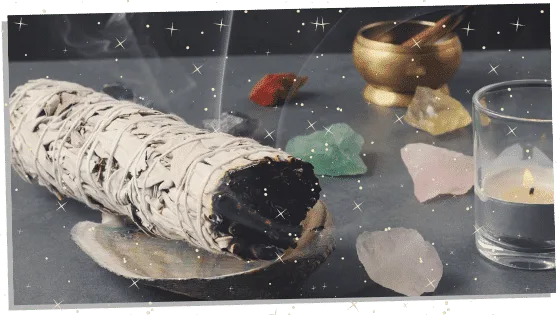
The abalone shell is a traditional part of the Indigenous American smudging tradition.
At the time, abalone shells were very common along the coast of the United States. The shells are highly decorative and can have a beautiful iridescent sheen inside.
Many people prefer not to use an abalone shell anymore, both due to the culturally appropriative nature of their use and also because abalone numbers are dwindling due to overfishing, both as food and as a decorative shell.
If you prefer not to use an abalone shell, a heat-proof clay or copper dish is the next best alternative to begin smudging with.
Do you need a feather to smudge?
The use of feathers in smudging is also a part of the Indigenous American tradition, where an eagle feather is commonly used.
The use of a feather is not an essential part of the process, except in some specific ritual cases.
In general, it is better to use a feather found or freely given, particularly something more local to you as many eagle species are also decreasing in number.
A fan is also an acceptable substitute for a feather in almost all cases as it is less appropriative and more suitable for vegans or those with a care in animal welfare.
Related post: Understand the spiritual meaning of feathers and their role in spiritual symbolism.
How do you light sage for smudging?
Hold your smudge stick over your fire-proof shell or bowl.
Using you candle (or other fire lighting source), set fire to the end of the stick furthest from your hand.
Let the fire kindle the whole end of the stick. Blow out the flame gently, leaving the embers glowing.
When you are still a beginner to smudging, it is quite acceptable to use matches or a lighter to get your smudge started.
It is up to you if you choose to fully burn your smudge stick or if you plan to keep it for future use.
Never leave a smoldering smudge stick unattended and if you decide not to burn it through, make sure it is fully out and cool before attempting to store it.
Can I use herbs other than sage for smudging?
While white sage is the most common form of smudge used, this too is descended from the Indigenous American tradition, particularly from around the California and New Mexico regions.
There are a range of other types of sage that are more common in other areas and the Salvia genus contains nearly 1000 species, including the psychoactive Salvia divinorum which is not suitable for smudging.
Other herbs and resins are suitable for smudging, including cypress, pine, eucalyptus, rosemary, sweetgrass and blends of the above.
Some smudge sticks are also available with dried flowers included to vary the scent provided.
I hope you have found this ‘Beginners Guide to Smudging’ to be a helpful and useful addition to your spiritual journey and that helps you to practice your smudging safely and confidently.
❤️ Related Posts:
- How To Cleanse Crystals With Sage? Step By Step Guide
- Palo Santo vs Sage [The Correct Time to Use Each One]
- Spiritual Herbs: 6 Amazing Herbs to Use in Your Spiritual Practice
- How To Use The Power Herbs To Attract Money – With Herb List
Alan is the founder of Subconscious Servant. He has a passion for learning about topics such as spirituality and the metaphysical world. The thing he loves to explore most though is manifesting with the law of attraction ✨.

